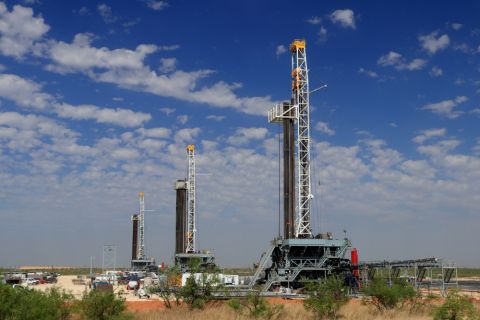
To meet natural gas takeaway demand by 2026, a final investment decision on a new Permian Basin pipeline will be needed before the end of the year, according to Enverus analysis. (Source: Shutterstock.com)
All eyes are on the Matterhorn Express Pipeline, which is expected to begin service over the next few months and alleviate some of the takeaway demand tightening the Permian Basin.
But not for long—a logjam in natural gas takeaway capacity is expected again in the Permian Basin sooner rather than later, according to analysis by Enverus.
“The Matterhorn Express pipeline will provide temporary alleviation in the Permian, but by 2026 more pipe is needed. There are four proposed projects that could help fill the required capacity, however they are all yet to reach an FID,” or final investment decision, wrote Jason Feit, author of the Enverus report, a forecast of gas pipeline capacity and constraints in the region.
The natural gas lines coming out of the Permian have been running at or near capacity since the middle of 2023, according to data from BTU Analytics.
The Matterhorn is a 2.5 Bcf/d, 580-mile pipeline that runs from the Permian to Katy, Texas, near Houston, and is expected to provide capacity relief in a basin where natural gas at the nearest price point, the Waha Hub, has been near or below $0 for much of 2024.
The extra capacity isn’t expected to last. The Permian is an oil-focused basin producing natural gas as a by-product. As shale plays mature, the gas-to-oil ratio tends to increase.
According to the Enverus forecast, the Matterhorn will run out of capacity in the back half of 2026 — and a quarter of the Permian’s gas production could be at risk by 2030 if new infrastructure does not come online before then.
Four more major pipeline projects have been proposed for the basin. None have reached FID, and the midstream companies behind the projects have a limited amount of time if they want to be ready by 2026.
“If we believe the (Matterhorn) is full by third-quarter 2026, which we currently do, and given these pipes probably take about two years to get in the ground and up and running — we’re really running out of time to make an FID,” Feit said in an interview with Hart Energy.
The four major proposed pipelines are Targa’s Apex, Energy Transfer’s Warrior, ONEOK’s Saguaro Connector and Moss Lake Partners’ DeLa Express. All are expected to carry 2 Bcf/d or more of natural gas to various locations in Texas, Louisiana or Mexico.
Feit said the companies are most likely working behind the scenes with suppliers, attempting to line up shipping commitments to firm up the economic feasibility of the project before going forward.
One wildcard for the timing of an FID is Kinder Morgan’s proposed expansion on the Gulf Coast Express. The project could be implemented quickly but would add only 500 MMcf/d of takeaway capacity, giving other projects a “buffer” before an FID would need to be made, Feit said.
‘Black box’
Complicating the issue for midstream companies is that much of the production and transport activity of their Texas competitors is unknown. Feit described the Permian as a “black box,” thanks to Texas regulations that do not require extensive public disclosures.
The Federal Energy Regulatory Commission governs pipelines that cross state borders and requires pipeline flows to be publicly disclosed. The rules make production easy to follow in a state such as Kentucky, which would have to transport its gas over a state line to move it to another market.
In Texas, the oil and gas produced in the nation’s most productive play can be processed and transported to international terminals on the Gulf Coast without ever crossing a state line. Analysts are therefore forced to estimate the production and flows of much of the state’s oil and natural gas through secondary means, such as intake at LNG plants or on traffic that goes outside the state.
“Any attempt to fully understand Permian gas takeaway capacity is as much art as it is science,” he said.
Recommended Reading
Exclusive: XCL Increases Production Amidst Lookout for More Inventory
2024-06-07 - XCL Resources is beginning its journey to acquire Altamont Energy, but in the meantime, the company is refining its operations in the Uinta Basin to find the perfect lateral length.
Beetaloo Juice: US Shale Explores Down Under
2024-06-28 - Tamboran Resources has put together the largest shale-gas leasehold in Australia’s Beetaloo Basin, with plans for a 1.5+ Bcf/d play. Behind its move now to manufacturing mode are American geologists and E&P-builders, a longtime Australian wildcatter, a U.S. shale-rig operator and a U.S. shale pressure-pumper.
Crackin’ It at Kraken: Inside the Bakken’s Ramped-up Private E&P
2024-07-24 - Kayne Anderson-backed Kraken Resources is producing more than 80,000 boe/d today and has a new Fitch Ratings credit score to take to the M&A bank.
EOG: Utica Oil Can ‘Compete with the Best Plays in America’
2024-05-09 - Oil per lateral foot in the Utica is as good as top Permian wells, EOG Resources told analysts May 3 as the company is taking the play to three-mile laterals and longer.
SM Energy Targets Prolific Dean in New Northern Midland Play
2024-05-09 - KeyBanc Capital Markets reports SM Energy’s wells “measure up well to anything being drilled in the Midland Basin by anybody today.”





